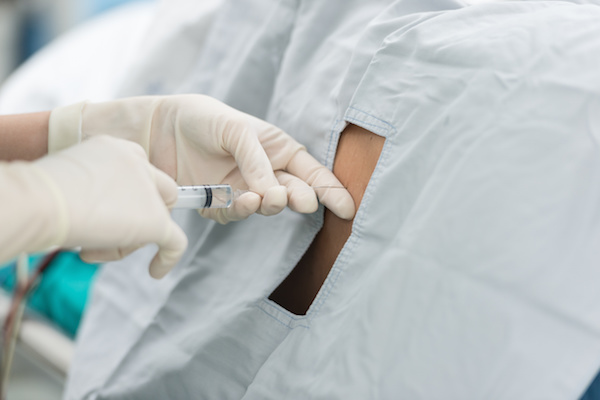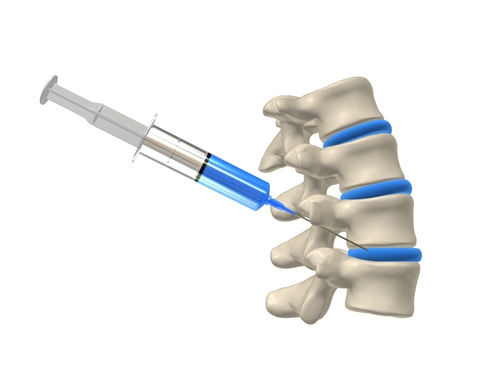Injection Therapy
Alleviating pain stemming from inflamed spinal structures in the body is the goal of steroid injection therapy. The injection itself is NOT a cure in the sense that it changes your anatomy by putting discs back into place, decompressing spinal stenosis, or reversing facet joint arthritis. However, it can provide sufficient pain relief, especially during an acute episode of pain, allowing the patient to progress further with physical therapy and rehabilitation programs and use less pain medication.
Steroid medication is directly (or very near) injected into the pain generator. Additionally, the volume of medicine “flushes out” the inflammatory proteins and chemicals from the local area that may be contributing to the production of pain.
There are several types of injections, and they are named after the body part that the medication is being injected into:
Interlaminar epidural/Caudal injection
An anesthetic and steroid medication injection is used to treat back pain, neck pain, or sciatica/radiculopathy. A spinal needle is inserted into the epidural space of the cervical, thoracic, lumbar, or caudal spine (depending on where the symptoms are and what access is available to the inflamed structure) to target the nerve roots in the spinal canal. X-ray guidance is used. The procedure can take up to 20-30 minutes, plus approximately 45 minutes of recovery time.
Selective nerve root/Transforaminal epidural injections
Using a different approach to access the epidural space in the spinal canal, a spinal needle is inserted into the area adjacent to the nerve root, and medication (anesthetic and steroid) is injected. X-ray guidance is used during the procedure, and it can take up to 20-30 minutes, in addition to approximately 45 minutes of recovery time.
Discography/Intradiscal injection
During this procedure, X-ray guidance is used. This is a diagnostic test to view and assess the internal structure of the disc and determine if it is a source of pain. Essentially, it is analogous to “pressing/palpating” on the disc to see if it is painful/inflamed. If so, we may inject medication (anesthetic and steroid) to ease pain and inflammation. So we can identify disc abnormalities using a CT scan, we inject contrast dye into the disc. We look for annular tears, scarring, disc bulges, and other changes to the disc nucleus. The procedure can take up to 30 to 45 minutes, plus 30 minutes if a CT scan is indicated, plus approximately 45 minutes of recovery time. A Spine Surgeon usually requests this to help determine which discs should be operated on or not.
Sacroiliac injection
The sacroiliac joints are in the lower back and buttocks region. They connect the sacrum (the triangular bone at the bottom of the spine) with the pelvis (iliac bone).X-ray guidance is used. A sacroiliac injection delivers an anesthetic and steroid into the sacroiliac joint and its surrounding structures. The procedure can take up to 20-30 minutes, plus approximately 45 minutes of recovery time.
Zygapophysial (facet) joint injection
A facet joint injection is directed to a pain-producing facet joint, a small stabilizing joint located between and behind the vertebra in the spine. X-ray guidance is used. A spinal needle is inserted into the facet joint or capsule and its surrounding structures, and an anesthetic or combined anesthetic and corticosteroid mixture is injected. The procedure can take up to 30 minutes, plus approximately 45 minutes of recovery time.
Radiofrequency medial branch ablation/neurotomy
This therapeutic procedure is performed for facet joint pain once it is identified as the primary pain generator through facet joint injections. It involves interrupting the nerve supply to the facet joint, which are called the medial branches. X-ray guidance is used. Radiofrequency probes or needles are placed on the two medial branches that innervate each facet joint. The needles are heated to 80 degrees Celsius for 90 seconds, sufficiently heating the nerve to cause denervation. Medication (anesthetic and steroid) is injected afterward. Pain relief and can last from 3 to 18 months. The nerve eventually grows back, and the procedure can be repeated. The process can take up to 30 to 45 minutes, plus approximately 45 minutes to 1 hour of recovery time.
Sympathetic Injection
This injection is diagnostic and can be therapeutic. It is performed to determine if there is damage to the sympathetic chain of nerves (that control involuntary reflexes) that may be malfunctioning. This condition is known as reflex sympathetic dystrophy syndrome (RSD) or complex regional pain syndrome (CRPS). X-ray guidance is used. A spinal needle is inserted along the sympathetic chain next to the vertebral body. Medication (anesthetic and steroid) is injected. The procedure can take up to 20-30 minutes plus approximately 45 minutes to one hour of recovery time. For a lumbar sympathetic chain injection, you generally can expect redness and a feeling of warmth in the lower extremities, lasting four to eight hours after the injection. For a cervical sympathetic chain (stellate ganglion) injection, in addition to warmth and redness of the upper extremities, a hoarse voice, eye redness, drooping eyelid, and pupillary constriction can be expected, lasting four to eight hours after injection.
Trigger point injection
A trigger point is an area of muscle that contains trigger points, or knots of muscle that form when muscles do not fully relax. These trigger points my irritate the nerves around them and can cause referred pain that is felt in another part of the body. Theinjection targets a specific spot in the muscles that is “triggering” the pain. The injection numbs the spot using an anesthetic, which may be combined with a corticosteroid to reduce inflammation, and then the needle mechanically breaks up the nodule or “taut band” that forms the trigger point.The procedure can take up to 5-10 minutes plus approximately 15 minutes of recovery time.
Occipital Nerve Injection
Traveling through the muscles located at the back of the head, into the scalp, the greater and lesser occipital nerves are located just above the neck area on both sides, emerging from between the upper neck bones. Inflammation or irritation of these nerves can cause one-sided headaches known as occipital neuralgia. An occipital nerve injection delivers an anesthetic and steroid around the occipital nerves and their surrounding structures. The procedure can take up to 10-20 minutes, plus approximately 15 minutes of recovery time.
Hip Joint Injections
The hip joint is a large joint where the leg joins the pelvis. If this joint experiences arthritis, injury, or mechanical stress, one may experience hip, groin, buttock, leg, or low back pain.X-ray guidance is used. A hip joint injection delivers an anesthetic and steroid into the hip joint. The procedure can take up to 20-30 minutes, plus approximately 30 minutes of recovery time.


